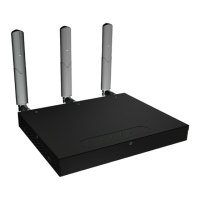C
HAPTER
8
| Wireless Settings
Radio Settings
– 86 –
◆ Preamble Length — The radio preamble (sometimes called a header)
is a section of data at the head of a packet that contains information
that the wireless device and client devices need when sending and
receiving packets. You can set the radio preamble to long or short. A
short preamble improves throughput performance, whereas a long
preamble is required when legacy wireless devices are part of your
network.
◆ Beacon Interval (20-1000) — The rate at which beacon signals are
transmitted from the access point. The beacon signals allow wireless
clients to maintain contact with the access point. They may also carry
power-management information. (Range: 20-1000 TUs; Default:
100 TUs)
◆ Data Beacon Rate (DTIM) (1-255) — The rate at which stations in
sleep mode must wake up to receive broadcast/multicast
transmissions.
Known also as the Delivery Traffic Indication Map (DTIM) interval, it
indicates how often the MAC layer forwards broadcast/multicast traffic,
which is necessary to wake up stations that are using Power Save
mode. The default value of 2 indicates that the access point will save all
broadcast/multicast frames for the Basic Service Set (BSS) and forward
them after every second beacon. Using smaller DTIM intervals delivers
broadcast/multicast frames in a more timely manner, causing stations
in Power Save mode to wake up more often and drain power faster.
Using higher DTIM values reduces the power used by stations in Power
Save mode, but delays the transmission of broadcast/multicast frames.
(Range: 1-255 beacons; Default: 1 beacon)
◆ RTS Threshold (0-2345) — Sets the packet size threshold at which a
Request to Send (RTS) signal must be sent to a receiving station prior
to the sending station starting communications. The access point sends
RTS frames to a receiving station to negotiate the sending of a data
frame. After receiving an RTS frame, the station sends a CTS (clear to
send) frame to notify the sending station that it can start sending data.
If the RTS threshold is set to 0, the access point always sends RTS
signals. If set to 2347, the access point never sends RTS signals. If set
to any other value, and the packet size equals or exceeds the RTS
threshold, the RTS/CTS (Request to Send / Clear to Send) mechanism
will be enabled.
The access points contending for the medium may not be aware of each
other. The RTS/CTS mechanism can solve this “Hidden Node Problem.”
(Range: 0-2345 bytes: Default: 2345 bytes)
◆ Short Guard Interval — The 802.11n draft specifies two guard
intervals: 400ns (short) and 800ns (long). Support of the 400ns GI is
optional for transmit and receive. The purpose of a guard interval is to
introduce immunity to propagation delays, echoes, and reflections to
which digital data is normally very sensitive. Enabling the Short Guard
Interval sets it to 400ns. (Default: Disabled)

